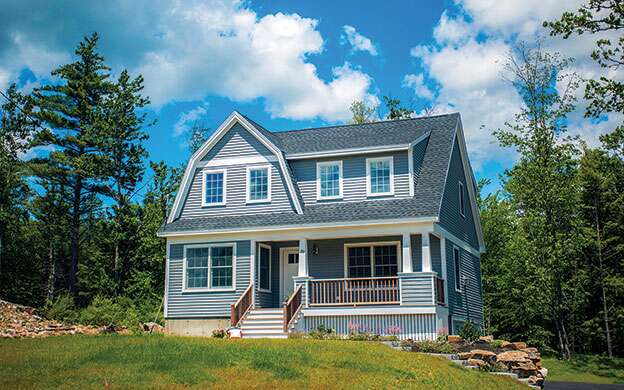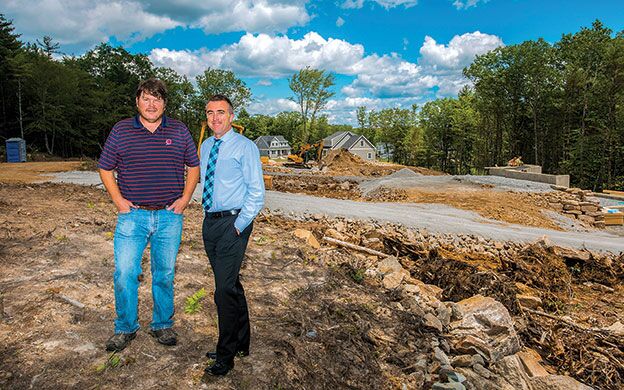
Homing in on York County: As existing homes fly off the shelf, new construction booms
York County is becoming a residential hot spot. Existing homes are being snapped up by buyers who don't seem to mind the escalation of prices in what is clearly becoming a seller's market.
Buyer activity has resulted in a tighter inventory that's producing a new-home construction boom. It's all largely thanks to downsizing baby-boomers, up-scaling millennials, vacationers-turned-year-round residents and out-of-staters seeking affordability coupled with an easy commute to urban centers. Buyers are paying a premium on asking prices. And for the first time since the recession, developers are building on spec, confident buyers will materialize.
“New construction seems to be flying off the shelf,” says Jeffrey Jellison, a broker and residential real estate developer in York that has a 33-home subdivision under construction. “In the last year alone, we've built and closed on seven homes.”
Four of those were in 2017, with two more scheduled by mid-summer, and speculative construction of four on tap. “More times than not, once you get to the point of putting up the sheetrock, a buyer shows up,” Jellison says.
According to the Maine Association of Realtors, an analysis based on data from Jan. 1, 2004, through Dec. 31, 2016, shows that York County accounts for nearly 18% of the single-family home sales in Maine — the equivalent of Aroostook, Franklin, Piscataquis, Sagadahoc, Somerset, Waldo and Washington counties combined.
Tighter inventory of single-family homes is having an impact across Maine. A June 21 Maine Association of Realtors report says Maine saw an 8.85% decline in May sales, a reflection of the 20% decline in inventory of homes on the market compared with May 2016.
Statewide, demand caused a 5.12% increase in the median sales price, from $190,250 in May 2016 to $200,000 in May 2017.
Demand is fueling higher prices
In York County for the period of March 1 through May 1, 748 single-family homes were sold in 2016, compared with 675 in 2017. Median sales prices rose 7.61% in the same period, from $230,000 to $247,500.

But the trend varies throughout the county, notes Jellison, broker/owner of Century 21 Atlantic Realty in York.
“It's different between towns,” says Jellison. In the town of York, for example, Jellison's recent inventory of included 205 single-family homes and condos. But his Ogunquit inventory was 34 properties.
Still, York County has seen a surge of new home construction.
Jellison, who is also part-owner of Atlantic Construction/DLJ Corp. in York, is building a 33-lot subdivision in York.
Building primarily for the middle-income market, Jellison says buyers are scaling up what they're willing to pay.
“Our price points were right around $395,000 at the end of last year,” he says. “Now they're averaging $445,000. And by the end of the year, they'll average closer to the $500,000 mark, because of demand. If you build, they will come — that's definitely applying here. We're putting them up as quickly as we can.”
Of the 33 lots, 15%, or up to five, will be set aside for lower-income buyers, in collaboration with York Housing Authority.
Who's buying?
Greg Gosselin, Maine Association of Realtors' 2017 president and broker-owner of the Gosselin Realty Group in York, attributes York County's popularity to location.
“York is really a bedroom community of Boston,” Gosselin says. “The residential market here was going up in the early 2000s, because people were finding it difficult to buy in Massachusetts, and Maine was affordable and people realized it was a commute away. It got a lot of people's attention, that it wasn't just a vacation destination. In 2008, the economy collapsed and, with that, real estate followed suit. But in 2010, the market kicked back in again.”
That doesn't mean all buyers are coming “from away.” Gosselin estimates Maine residents account for 70% of York County buyers, followed by Massachusetts and New Hampshire.
Demographics vary, he says. Typical Maine-based buyers include retired couples downsizing and perhaps moving from countryside to town; and younger generations sizing up. York County is also big with out-of-staters looking for vacation homes suitable for later retirement. Other buyers seek investment properties, capitalizing on Maine's cachet as a vacation destination.
Also discussing the existing-home market, Steve Brunette, a Realtor with Better Homes & Gardens Real Estate–The Masiello Group in Sanford, says he sees considerable real estate activity in his inland area. He's also seeing an influx of buyers from Massachusetts and New Hampshire, again, partly due to lower prices.
For a starter house, Brunette says, “In southern New Hampshire, around the Portsmouth area, that same house is probably going to cost you another 10% at least. Then in Massachusetts, it could be another 15% or 20% as you get closer to Boston.”
Multiple offers on homes is common and buyers are willing to pay $10,000 to $20,000 over list price, Brunette says.
“If the home is in a decent location, if it's been well maintained and it's priced properly, in most cases it's going to go in heartbeat,” Brunette says. “We're seeing some frustration on the buyers' part, when they've made good offers on properties and come to find out there were three or four other offers at the same time — from other people willing to pay more money.”
He adds, “Not long ago, I listed a home in our MLS [multiple listing service] on a Sunday night at 10 p.m. My phone started ringing first thing Monday morning. By Tuesday, I had 21 showings and seven offers. It was under contract by Tuesday evening, and six of those offers were for more than the listed price.”
Brunette expects the activity to continue.
“In the foreseeable future, I don't see anything that's going to make it change,” he says. “Interest rates are creeping up a touch, but it's not enough to turn anyone off. It's still hovering at 4% or just above. That's darn good.”
Some sellers are having a hard time moving up, says Brunette.
“[In the past] the normal progression was, I might have sold someone their first home, they fixed it up, the family grew, they changed jobs and then they're looking for something bigger and better six or seven years later. So they put their house on the market, and when their house went under contract, there was a big inventory and they could immediately find a home,” Brunette says.
“The problem we have now is that, when people put their house on the market, there's not a lot of inventory out there and there's nothing to move to,” he says. “It's causing some heartache.”
Low inventory
The struggle to nail down an existing home is driving new construction, Realtors and developers agree.
“I have two couples I've been working with,” says Brunette. “For about three weeks they were looking in the Wells area for something in the mid-$300,000s to lower $400,000s. Both couples had a hard time finding anything and both are interested now in having a home built.”
“Right now, we can't build fast enough,” says Bob Georgitis, vice president and project manager for Kasprzak Builders in North Waterboro.
The firm, which builds 32 to 36 mid-income condo units per year, in the mid-$300,000 to mid-$400,000 range, currently has enough construction work for nearly a year, he says. A 56-unit condominium complex in Wells, Heron Landing at Riverbend Woods, was most recently completed.
“Most people buying our condominiums are retirees or are getting ready to retire,” says Georgitis. “About 50% are from out-of-state and the others are people pretty much from southern Maine — they're downsizing and up-scaling from their big houses into condominiums, looking to get away from maintenance issues like shoveling snow and mowing the grass. That's what condo buying is all about.”
“Three years ago, I didn't know where my next job was coming from. Now it's a feast,” agrees Biddeford developer Doug Sanford, adding, “Every excavator and construction guy I know is very busy.”
Sanford is the owner/developer of the 1 million-square-foot Pepperell Mill in Biddeford, now home to 120 businesses and 100 market-rate rental apartments in the moderate to high-income range. Occupancy is 100%. He plans to develop another 80 units once financing is secured.
“[Tenants] might want to be in Portland, but Portland's too expensive, so they're looking at Saco and Biddeford,” Sanford says.
Labor shortage
Predictably, contractors say a shortage of workers is tempering growth.
“It's across all the trades — plumbers, carpenters, framers,” says Georgitis. “We build year-round, and there are not many guys who want to be outside when it's 10 above, banging nails. But to provide these products, you've got to build year-round.”
Georgitis offers an example of the shortage. On a recent June day, at the company's three job sites, 40 to 50 people are employed by Kasprzak's sub-contractors, working on condos in various stages of construction, from digging holes for the foundation, to framing, sheetrocking, wiring and plumbing. All together, he estimates the crews could use 10 more people.
“The building's framing crew manpower is short-staffed by 25% to 30% and other trades by 10% to 20%,” he says.
Sanford says the shortage results in an extended construction timeframe.
“For the 80 residential units, we could use a lot more workers,” he says. “Instead of telling tenants, 'I can get you in, in six months,' I'd be able to tell them two months.”
Paul Schumacher, executive director of the Southern Maine Planning and Development Commission, said before the recession he had two to three people reviewing projects.
“After the crash, we had hardly anyone doing that,” Schumacher says. “But in the last couple of years, it's picked up dramatically. We get a lot more requests from a lot more towns for assistance as far as reviewing development proposals. And it's wide-ranging: It's not just the coastal towns. Within the last six to nine months in towns like South Berwick, Waterboro, Hollis and Parsonsfield, we were helping planning boards with six to seven subdivisions totaling about 150 lots.”
On the plus side, the boom is creating jobs and housing in a diverse range to attract more people to the region.
“The downside is that there is a fear that additional development means more children, increased school costs, loss of open space and in a general sense, loss of quality of life,” he says. But, he adds, “If development occurs in a 'smart' way, all of this can be managed and balanced. That would be the best of all outcomes.”













Comments